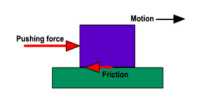By Newton’s second law of motion, the force acting on a body = m a, where m = mass of the body and a = acceleration produced.
The impulse of the force = F x t = (m a) t
If u and v be the initial and final velocities of the body then, a = (v-u)/t
Therefore. impulse of the force = m x [(v – u)/t] x t = m(v–u) = mu – mu
Impulse = final momentum of the body – initial momentum of the body.
So, Impulse of the force = Change in momentum
The above equation shows that the total change in the momentum of a body during a time interval is equal to the impulse of the force acting during the same interval of time. This is called principle of impulse and momentum.
Examples
(i) A cricket player while catching a ball lowers his hands in the direction of the ball.
If the total change in momentum is brought about in a very short interval of time, the avenge force is very large according to the equation. F = (mv-mu)/t
By increasing the time interval, the average force is decreased. It is for this reason that a cricket player while catching a ball, to increase the time of contact, the player should lower his hand in the direction of the ball . so that he is not hurt.
(ii) A person falling on a cemented floor gets injured more where as a person falling on a sand floor does not get hurt. For the same reason, in wrestling, high jump etc., soft ground is provided.
(iii) The vehicles are fitted with springs and shock absorbers to reduce jerks while moving on uneven or wavy roads.











